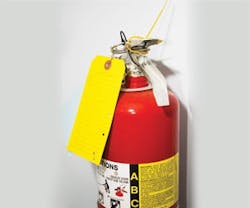How many hours does your staff spend completing monthly inspections for your fire extinguishers? If you have a large facility or multiple properties, the answer could be too many.
To save time and labor costs, leverage several existing technologies to digitally monitor your fire extinguishers, quickly update inventory records, and remotely access your CMMS.
Upgrade with Digital Sensors
Instead of sending someone around with a clipboard, install an electronic monitoring system. It strengthens your life safety systems by providing continuous monitoring and reducing the possibility of human errors or negligence. By eliminating the required monthly inspection, it also frees up your maintenance personnel for other tasks and allows you to reroute the labor savings.
These devices are paired with each fire extinguisher and use a smart pressure gauge to continuously check for fluctuations. The monitoring devices can even be paired with defibrillators and medical oxygen tanks.
The system reports a host of conditions, including pressure levels and charge status. When equipped with an obstruction sensor, it can also detect if the fire extinguisher is blocked, has been tampered with, or is missing from its mount.
“The electronic monitoring systems are easily connected to your fire alarm or security system,” says Chris Jelenewicz, an engineering program manager for the Society of Fire Protection Engineers. It can be programmed to send out full alarms to the fire control panel or supervisory messages to maintenance personnel when safety concerns are indicated.
Not only is this helpful when a fire extinguisher’s pressure drops to unsafe levels, but remote monitoring is ideal for facilities that have a high occurrence of vandalism, such as schools and universities. This allows misplaced, stolen, or compromised extinguishers to be replaced more quickly while resolving potential code violations.
If you don’t have an easy way to physically connect the system to your network, try wireless options instead. Like any other fire protection system, digital monitoring devices need good design, installation, and maintenance to function properly.
“It’s always a good idea to have a fire protection engineer be part of designing the electronic monitoring system, particularly if you’re connecting it to an existing fire alarm system,” recommends Jelenewicz.
An electronic monitoring system will change your fire protection program, requiring you to update your fire plans to account for the new inspection schedule and repair protocol. Note that while digital monitoring eliminates the monthly inspection, it does not apply to annual testing requirements. It may also be prudent to conduct a visual inspection quarterly in case the monitoring system has any failures.
Get Smart with Bar Codes
With the growing acceptance of BIM, there are new and emerging ways to digitally keep track of your fire extinguisher inventory.
John D’Angelo, senior director for facilities at the Cleveland Clinic, manages a portfolio of over 200 buildings. With thousands of fire extinguishers to inspect, D’Angelo needed a better way to manage inventory and speed up maintenance repairs.
An opportunity presented itself when the clinic merged its CMMS and building control systems onto one platform. Armed with a new ability to share data, D’Angelo outfitted each fire extinguisher with a bar code and had staff use a tablet with a bar code scanner on it to complete inspections.
Not only are the tablets remotely tied to the CMMS, but they also contain drawings of the fire extinguishers. Repairs can be documented with the camera feature and automatically loaded to keep records dynamic and visual.
The bar code-tablet system has greatly improved the clinic’s ability to accurately inspect fire extinguishers, which strengthens its code compliance and improves the overall safety of the facility. It is also one more step on the way to implementing BIM for FM throughout Cleveland Clinic properties.
You can remotely monitor entrances, parking lots, HVAC systems, energy spend, and now fire extinguishers with technology. By using digital monitoring methods, you will gain back time and labor costs while improving your life-safety measures.
Jennie Morton ([email protected]) is associate editor of BUILDINGS.
About the Author
Jennie Morton
A former BUILDINGS editor, Jennie Morton is a freelance writer specializing in commercial architecture, IoT and proptech.
